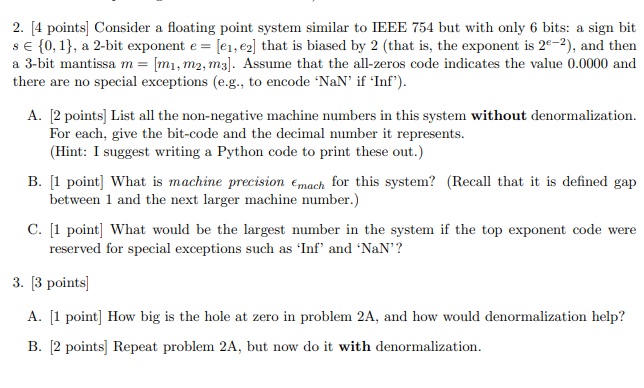
2. [4 points] Consider a floating point system similar to IEEE 754 but with only 6 bits: a sign bit SE {0,1), a 2-bit exponent e = [ei, ez] that is biased by 2 (that is, the exponent is 20-2), and then a 3-bit mantissa m= [mi, m2, m3]. Assume that the all-zeros code indicates the value 0.0000 and there are no special exceptions (e.g., to encode 'NaN' if 'Inf'). A. [2 points List all the non-negative machine numbers in this system without denormalization. For each, give the bit-code and the decimal number it represents. (Hint: I suggest writing a Python code to print these out.) B. 1 point) What is machine precision mach for this system? (Recall that it is defined gap between 1 and the next larger machine number.) C. (1 point) What would be the largest number in the system if the top exponent code were reserved for special exceptions such as 'Inf' and 'NaN'? 3. [3 points) A. [1 point] How big is the hole at zero in problem 2A, and how would denormalization help? B. [2 points) Repeat problem 2A, but now do it with denormalization. 2. [4 points] Consider a floating point system similar to IEEE 754 but with only 6 bits: a sign bit SE {0,1), a 2-bit exponent e = [ei, ez] that is biased by 2 (that is, the exponent is 20-2), and then a 3-bit mantissa m= [mi, m2, m3]. Assume that the all-zeros code indicates the value 0.0000 and there are no special exceptions (e.g., to encode 'NaN' if 'Inf'). A. [2 points List all the non-negative machine numbers in this system without denormalization. For each, give the bit-code and the decimal number it represents. (Hint: I suggest writing a Python code to print these out.) B. 1 point) What is machine precision mach for this system? (Recall that it is defined gap between 1 and the next larger machine number.) C. (1 point) What would be the largest number in the system if the top exponent code were reserved for special exceptions such as 'Inf' and 'NaN'? 3. [3 points) A. [1 point] How big is the hole at zero in problem 2A, and how would denormalization help? B. [2 points) Repeat problem 2A, but now do it with denormalization







